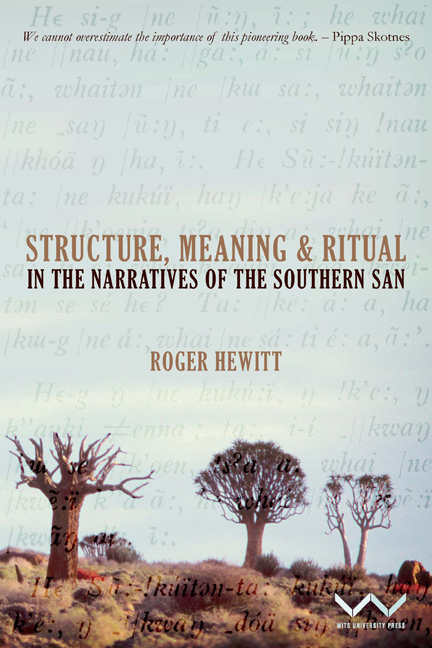Book contents
- Frontmatter
- Dedication
- Contents
- Acknowledgements
- Introduction
- 1 Ethnographic background
- 2 Introduction to the narratives: their context, performance and scope
- 3 Legends and the stories of !Khwa
- 4 Sidereal narratives: the story of the Dawn's Heart and his wife the Lynx
- 5 Animal narratives
- 6 |Kaggen in belief and ritual
- 7 The |Kaggen narratives (1): characters and content
- 8 The |Kaggen narratives (2): sequence and structure
- 9 |Kaggen in belief, ritual and narrative: a synthesis
- 10 Two |Kaggen narratives: compositional variations
- 11 The verbal surface: a note on the narrators
- Appendix A Girls’ puberty observances of the ǀXam
- Appendix B The shamans of the ǀXam
- Bibliography
- Index
8 - The |Kaggen narratives (2): sequence and structure
Published online by Cambridge University Press: 21 April 2018
- Frontmatter
- Dedication
- Contents
- Acknowledgements
- Introduction
- 1 Ethnographic background
- 2 Introduction to the narratives: their context, performance and scope
- 3 Legends and the stories of !Khwa
- 4 Sidereal narratives: the story of the Dawn's Heart and his wife the Lynx
- 5 Animal narratives
- 6 |Kaggen in belief and ritual
- 7 The |Kaggen narratives (1): characters and content
- 8 The |Kaggen narratives (2): sequence and structure
- 9 |Kaggen in belief, ritual and narrative: a synthesis
- 10 Two |Kaggen narratives: compositional variations
- 11 The verbal surface: a note on the narrators
- Appendix A Girls’ puberty observances of the ǀXam
- Appendix B The shamans of the ǀXam
- Bibliography
- Index
Summary
Bleek and Lloyd were unable to witness the performance of ǀXam narratives to a native audience and furthermore the method of transcription which they employed permitted little indication of the nature of performance to emerge. This has repercussions for any attempt to establish a possible fixed sequence to these narratives. Bleek's main informant, ǁKabbo, gave the majority of his ǀKaggen narratives between September 1871, and January 1872. He often gave two or more versions of each narrative and moved from narrative to narrative, although on many occasions he also wandered from the narrative into accounts of the natural history of various animals or into other non-fictional subjects which interested him. In addition, he sometimes worked with Lloyd on a new narrative, having broken off in the middle of giving a narrative to Bleek on the previous day. These and other factors would inevitably disrupt any sequence which might have been customary. Even by comparing the embedding of narratives where continuing narration occurred, no consistent sequencing emerges; nor do any of the sequences employed by ǁKabbo coincide with the sequence given by Lloyd's informant ǀHang ǂkass'o although ǁKabbo and ǀHang ǂkass'o both progress from M8 to M9. (On other evidence it is also possible to see how these two narratives might have been necessarily linked. See Chapter 10.) Lloyd also felt that the events described by ǀHang ǂkass'o in M13 occurred ‘later’ than those in M12 (Lloyd 1889: 7). This hint of fixed sequence is not corroborated, however, for only single versions of M12 and M13 were collected.
A feature of ǀHang ǂkass'o's style is the linking of separate narratives with remarks such as, ‘After ǀKaggen's recovery from his sufferings (in M10) he went to the Ticks’ houses’ (M8). Thus the appearance of a fixed sequence is created, although on different occasions, to a native audience, ǀHang ǂkass'o may in fact still have varied the sequence while maintaining the appearance of a fixed connection. However, because, for the most part, he only gave single versions of narratives, comparison of sequence is not possible as it is in the case of ǁKabbo. Dia!kwain did not give a sufficient number of narratives for even a single sequence to be observed.
On the basis of the content of the narratives it is again impossible to see any necessary sequence such as Radin saw in the Winnebago cycle (Radin 1956: 132ff).
- Type
- Chapter
- Information
- Publisher: Wits University PressPrint publication year: 2008



